
Attacus atlas, the Atlas moth, is a large saturniid moth endemic to the forests of Asia. The species was described by Carl Linnaeus in his 1758 10th edition of Systema Naturae.

Saturniidae, members of which are commonly named the saturniids, is a family of Lepidoptera with an estimated 2,300 described species. The family contains some of the largest species of moths in the world. Notable members include the emperor moths, royal moths, and giant silk moths.
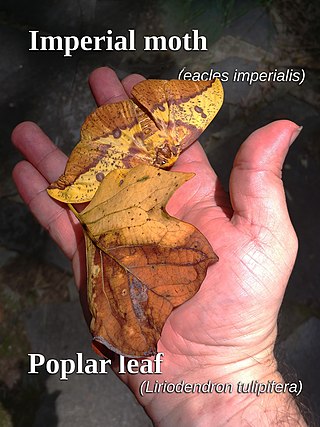
Eacles is a genus of moths in the family Saturniidae. They are native to the Americas. The genus was erected by Jacob Hübner in 1819.

The dryandra moth is a species of moth that is considered to be the sole member of the family Carthaeidae. Its closest relatives are the Saturniidae and it bears a resemblance to many species of that family, bearing prominent eyespots on all wings. The common name is derived from the Dryandra shrubs of the genus Banksia, on which the larva of this species feed, and is hence restricted to the south-west of Western Australia where these shrubs grow. Other Grevillea shrubs may also be used as host plants.

Caligula is a genus of moths of the family Saturniidae. It is primarily an Oriental genus, found in India, China and Southeast Asia. The genus is often treated as a synonym of Rinaca. It is named after Roman emperor Caligula.
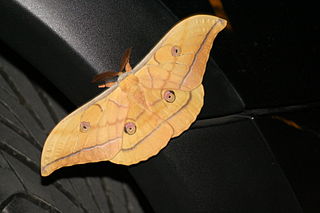
Antheraea yamamai, the Japanese silk moth or Japanese oak silkmoth is a moth of the family Saturniidae. It is endemic to east Asia, but has been imported to Europe for tussar silk production and is now found in southeastern Europe, mainly in Austria, northeastern Italy, and the Balkans. It seems to be spreading north and a population has been reported near Deggendorf and Passau in Germany. The species was first described by Félix Édouard Guérin-Méneville in 1861. It has been hybridized artificially with Antheraea polyphemus of North America.
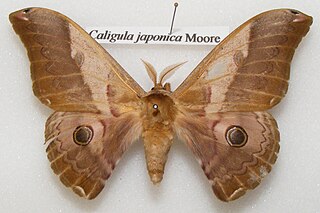
Caligula japonica, the Japanese giant silkworm, is a moth of the family Saturniidae. It was described by Frederic Moore in 1872. It is found in eastern Asia, including China, Korea, Japan and Russia.
Antheraea moultoni is a moth of the family Saturniidae first described by Watson in 1927. It is found in Borneo.

Antheraea celebensis is a moth of the family Saturniidae first described by Watson in 1915. It is found in Sulawesi and Sundaland.

Saturnia spini, the sloe emperor moth, is a moth of the family Saturniidae. The species was first described by Michael Denis and Ignaz Schiffermüller in 1775. It is found from eastern Austria and Poland across eastern and south-eastern Europe to Greece, Turkey, Armenia, Ukraine, and Kazakhstan.

Antherina is a monotypic moth genus in the family Saturniidae erected by William Elford Leach in 1815. Its only species, Antherina suraka, the Suraka silk moth, was first described by Jean Baptiste Boisduval in 1833. It is found on Madagascar and Mayotte. Both larvae and pupae consumed in parts of Madagascar, but not to a great extent. The larvae feed on oleander, privet, willows, beech, Liquidambar, Crataegus (hawthorns), grapevine, lilac, cherry, laurel, Forsythia, Rhus, Pistacia, apple, pear, plum and peach leaves, but foodplants differ from species to species. They start off black with yellow protrusions to eventually green with red and yellow on their bodies. Once they've finished growing they will be as thick as your finger and when they have reached their final days as a caterpillar they will develop a blue dorsal stripe and wander around looking for a place to pupate.
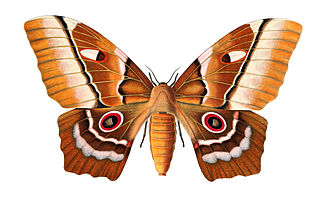
Pseudimbrasia is a monotypic moth genus in the family Saturniidae described by Pierre Claude Rougeot in 1962. Its only species, Pseudimbrasia deyrollei, described by James Thomson in 1858, is found in the mid-latitudes of Africa.
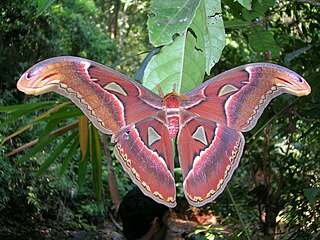
Attacus is a genus of moths in the family Saturniidae. The genus was named by Carl Linnaeus in his 1767 12th edition of Systema Naturae.

Automeris is a genus of moths in the family Saturniidae and the subfamily Hemileucinae. As of 1996 there were 124 species, and more have since been described. These moths are generally characterized by the eyelike patches on the hindwings and the leaflike pattern on the forewings, an example of crypsis. The genus was first described by Jacob Hübner in 1819 and it is distributed in the Neotropical realm.

Archaeoattacus is a genus of moths belonging to the family Saturniidae and subfamily Saturniinae. The species of this genus are present in the Himalayas, Sundaland and Peninsular Malaysia. The genus was first described by Watson in 1914.

Hemileuca is a genus of moths in the family Saturniidae first described by Francis Walker in 1855.

Samia is a genus of moths in the family Saturniidae. The genus was erected by Jacob Hübner in 1819.

Cricula is a genus of moths in the family Saturniidae first described by Francis Walker in 1855.
Solus is a genus of moths in the family Saturniidae first described by Watson in 1913.
















